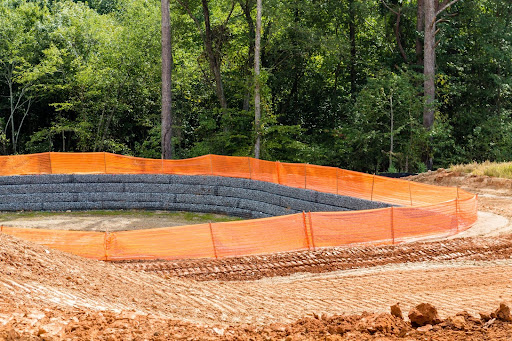A Step-by-Step Guide to Silt Fence Installation for Land Protection

Preserving the integrity of our land is essential for environmental sustainability. Silt fences play a vital role in preventing soil erosion and protecting natural resources. In this step-by-step guide, we will walk you through the process of installing a silt fence to ensure adequate land protection.
What are Silt Fences?
Silt fences are temporary sediment control devices designed to prevent soil erosion and control sediment runoff during construction, landscaping, or any activity that disturbs the soil. These fences are particularly useful in protecting nearby water bodies and maintaining water quality by trapping sediment and preventing it from entering stormwater drains, streams, rivers, or other water sources.
Key components of a silt fence include:
Silt Fabric
The primary component of a silt fence is a geotextile fabric that is permeable to water but retains sediment. This fabric is typically made of synthetic materials and is designed to allow water to pass through while trapping sediment particles.
Support Posts
Wooden or metal posts are driven into the ground to provide structural support for the silt fabric. These posts are strategically placed to create a continuous barrier along the desired perimeter.
Wire Ties
These are used to secure the silt fabric to the support posts, ensuring that the fence remains intact and effective. Wire ties help maintain tension in the fabric to prevent sagging or tearing.
Related: COMMON EROSION CONTROL PRODUCTS AND THEIR USES
The Correct Method of Silt Fence Installation
Silt fences are an essential erosion control measure, and their proper installation and maintenance contribute to environmental conservation. The right installation method involves positioning them strategically in areas prone to soil erosion, such as construction sites, slopes, or disturbed soil. The fences act as a barrier, slowing down water flow and allowing sediment to settle before the water reaches sensitive areas.
Here’s how you can do that:
1. Site Assessment
Conduct a thorough site assessment to identify areas prone to soil erosion. Look for slopes, construction sites, or disturbed soil that could contribute to sediment runoff. Understanding the specific characteristics of the site will help determine the appropriate placement and design of the silt fence. This initial step is essential for the overall effectiveness of the erosion control measure.
2. Gather Materials and Tools
Before beginning the installation, gather all the necessary materials and tools. This includes silt fabric, support posts, wire ties, and a post driver. Having all the required items ready ensures a smooth installation process and helps avoid delays. Create a checklist to ensure that nothing essential is overlooked.
3. Planning the Layout
Based on the site assessment, plan the layout of the silt fence. Consider the natural topography, water flow patterns, and potential erosion hotspots. The fence should be strategically positioned to intercept and slow down water, allowing sediment to settle. Adequate planning sets the foundation for an effective erosion control barrier.
4. Installing Fence Posts
Begin the installation by driving support posts into the ground. The spacing and depth of the posts are critical for the stability of the silt fence. Use a post driver to secure the posts in place firmly. Properly installed posts provide the necessary structural support for the silt fabric and contribute to the overall effectiveness of the erosion control measure.
5. Attaching Silt Fabric to Posts
Unroll the silt fabric along the length of the installed posts, ensuring full coverage of the designated area. Securely attach the fabric to each post using wire ties. Pay attention to maintaining consistent tension in the fabric to prevent sagging or gaps. A tightly secured fabric creates a continuous barrier that effectively captures sediment.
6. Ensuring Proper Tension
As you progress with attaching the silt fabric, periodically check and adjust the tension. Proper tension is essential for the silt fence to capture sediment effectively. If the fabric is too loose, it may allow sediment to escape, compromising erosion control efforts. Adjust the placement of posts or introduce tension wires to maintain optimal fabric tension throughout the installation.
7. Inspection and Adjustment
Regularly inspect the installed silt fence for any issues, such as tears in the fabric or loose posts. Address these concerns promptly to prevent potential failures in the erosion control system. Inspections should be conducted not only during installation but also periodically throughout the project to ensure continued effectiveness. Timely adjustments contribute to the long-term success of the silt fence.
8. Backfilling and Seeding
In situations where construction activities have left bare soil, consider backfilling the area with soil or adding a layer of mulch to stabilise the soil. Additionally, seeding the disturbed areas with erosion-resistant plants helps establish vegetation that further aids in soil retention. These additional measures complement the silt fence in preventing erosion and promoting sustainable land management.
9. Stormwater Management
Incorporate stormwater management practices alongside silt fence installation. Consider installing sediment basins or check dams upstream from the silt fence to trap larger sediment particles before they reach the protected area. Integrating multiple erosion control measures enhances the overall effectiveness of the system, especially during heavy rainfall or storm events.
Take Action for Sustainable Land Protection!
This concludes our guide to silt fence installation. Now, it’s time to put these practices into action. By following these steps and staying vigilant in your erosion control efforts, you can actively contribute to the preservation of our environment. Remember that ongoing inspection and maintenance are crucial for the sustained success of your erosion control measures. Implementing these steps not only protects the immediate construction site but also safeguards downstream water bodies, promoting responsible land management practices. If you are looking for silt fence products, get in touch with Ecospill today.
